In the mid-1930s, when the new mechanical hemp fiber stripping machines and machines to conserve hemp’s high-cellulose pulp finally became state-of-the-art, available and affordable, the enormous timber and acreage and businesses of the Hearst Paper Manufacturing Division, Kimberly Clark (USA), St. Regis – and virtually all other timber, paper and large newspaper holding companies – stood to lose billions of dollars and perhaps go bankrupt.
Coincidentally, in 1937, DuPont had just patented processes for making plastics from oil and coal, as well as a new sulfate/sulfite process for making paper from wood pulp. According to DuPont’s own corporate records and historians, these processes accounted for over 80% of all the company’s railroad car loadings over the next 60 years into the 1990s.
If hemp had not been made illegal, 80% of DuPont’s business would never have materialized and the great majority of the pollution which has poisoned our Northwest and Southeastern rivers would not have occurred. In an open marketplace, hemp would have saved the majority of America’s vital family farms and would have probably boosted their numbers, despite the Great Depression of the 1930s.
But competing against environmentally-sane hemp paper and natural plastic technology would have jeopardized the lucrative financial schemes of Hearst, DuPont, and DuPont’s chief financial backer, Andrew Mellon of the Mellon Bank of Pittsburgh.
Text and photos
Abel, Ernest, "Marijuana, The First 12,000 Years", 2005; Herer, Jack, “The Emperor Wears No Clothes”, AH HA Publishing, 2000; Popular Mechanics, June 1939, pg. 805; Popular Mechanics 'The New Billion Dollar Crop', February 1938, pg. 238-239; Robinson, Rowan, "The Great Book of Hemp", Park Street Press, 1996. Rothenberg, Erik “A RENEWAL OF COMMON SENSE: The Case for Hemp in 21st Century America” ©Vote Hemp, Inc.; Roulac, John W., “Hemp Horizons”, Chelsea Green Publishing Co., 1997; Various, “Journal of Industrial Hemp”, The Haworth Press, Inc., 1996.
In 1931, Andrew Mellon of the Mellon Bank of Pittsburgh, in his role as Herbert Hoover’s Secretary of the Treasury, appointed his future Nephew-in-law, Harry J Anslinger, to be head of the newly reorganized Federal Bureau of Narcotics and Dangerous Drugs (FBNDD), a post he held for the next 31 years.
These industrial barons and financiers knew that machinery to cut, bale, decorticate (separate the fiber from the high-cellulose hurd), and process hemp into paper or plastics was becoming available in the mid-1930s. Cannabis hemp would have to go.
In DuPont’s 1937 Annual Report to its stockholders, the company strongly urged continued investment in it’s new, but not readily accepted petrochemical synthetic products. DuPont was anticipating “radical changes” from “the revenue raising power of government… converted into an instrument for forcing acceptance of sudden new ideas of industrial and social reorganization.”
Concern about the effects of hemp smoke had already led to two major governmental studies. The British governor of India released the Report of the Indian Hemp Drugs Commission 1893-1894 on heavy bhang smokers in the subcontinent. And in 1930, the U.S. government sponsored Siler Commission study on the effects of off-duty smoking of marijuana by American servicemen in Panama. Both reports concluded that marijuana was not a problem and recommended that no criminal penalties apply to its use.
In early 1937, Assistant U.S. Surgeon General Walter Treadway told the Cannabis Advisory Subcommittee of the League of Nations that, “It may be taken for a relatively long time without social or emotional breakdown. Marihuana is habit-forming… in the same sense as… sugar or coffee.”
But other forces were at work. The war fury that led to the Spanish American War in 1898 was ignited by William Randolph Hearst through his nationwide chain of newspapers, and marked the beginning of “yellow journalism” as a force in American politics.
Webster’s Dictionary defines “yellow journalism” as the use of cheaply sensational or unscrupulous methods in newspapers and other media to attract or influence the readers.
In the 1920s and ‘30s, Hearst’s newspapers deliberately manufactured a new threat to America and a new yellow journalism campaign to have hemp outlawed. For example, a story of a car accident in which a “marijuana cigarette” was found would dominate the headlines for weeks, while alcohol-related car accidents (which outnumbered marijuana-connected accidents by more than 10,000 to 1) made only the back pages.
Much of the confusion between hemp and marijuana today can be traced back to the anti-drug campaigns that began in the 1920s. Even Matt Rens, the Wisconsin mill owner known as “America’s hemp king” because of his contributions to the advancement of the industry, was, in his ignorance of the facts, influenced by these campaigns. In 1940, Rens was quoted in the Milwaukee Journal saying, “We have enough marihuana on hand in stacks and in our warehouses to drug the nation, but I can’t recall a single case since I’ve been in the business where farmers or help around here smoked marihuana or put it to improper use.”
What Rens had on hand in such abundance was hemp, not marihuana – enough hemp to cause widespread headaches if smoked, but hardly a nationwide high.
The William Randolph Hearst theory alleges that the newspaper baron, who owned vast timberlands, conspired against the burgeoning hemp industry with the Dupont Corporation, which owned patents on nylon and plastic, in order to remove a formidable competitor.
The Racism Theory
The Racism Theory alleges that the anti-marijuana campaign was not directed against hemp, but targeted African-American jazz musicians and Hispanics in Southern border towns who were stereotypically associated with marijuana use.
Starting with the 1898 Spanish American War, the Hearst newspaper had denounced Spaniards, Mexican-Americans, and Latinos. After the seizure of 800,000 acres of Hearst’s prime Mexican timberland by the “marihuana” smoking army of Pancho Villa, these slurs intensified non-stop for the next three decades. Hearst painted a picture of the lazy, pot-smoking Mexican – still one of our most insidious prejudices. Simultaneously, he waged a similar racist smear campaign against the Chinese, referring to them as the “Yellow Peril.”
Hearst’s and other sensationalistic tabloids ran hysterical headlines atop stories portraying “negroes” and Mexicans as frenzied beasts who, under the influence of marijuana, would play anti-white “voodoo-satanic” music (jazz) and heap disrespect and “viciousness” upon the primarily white readership.
“The actual Spanish word for hemp is “canamo.” But using a Mexican “Sonoran” colloquialism – marijuana, often Americanized as “marihuana” – guaranteed that few would realize that the proper terms for one of the premier natural medicines, “cannabis,” and for the premiere industrial resource. “Hemp,” had been pushed out of the language. “– Jack Herer, Author, “The Emperor Wears No Clothes”
In 1937, Anslinger testified before Congress saying, “Marijuana is the most violence causing drug in the history of mankind.” This, along with Anslinger’s outrageous racist statements and beliefs, was made to a southern-dominated committee and is now an embarrassment to read in its entirety. For instance, Anslinger kept a “Gore File,” culled almost entirely from Hearst and other sensational tabloids e.g., stories of axe murders, where one of the participants reportedly smoked a joint four days before committing the crime.
Anslinger pushed on Congress as a factual statement that about 50% of all violent crimes committed in the U.S. were committed by Spaniards, Mexican-Americans and Greeks, and these crimes could be traced directly to marijuana. (From Anslinger’s own records, donated by him to Pennsylvania State University, ref.: LiCata Murders, etc.) Not one of Anslinger’s marijuana “Gore Files” of the 1930’s is believed to be true by scholars who have painstakingly checked the facts.
The Prohibition Bureaucracy Theory alleges that government agencies formerly responsible for enforcing the alcohol ban had nothing against hemp but needed to create a new villain (marijuana) in order to justify their continuing existence after Prohibition was repealed in 1933.
Deep in the throes of the Depression, Congress began to examine budgetary requirements from all federal agencies, and the Bureau of Narcotics was no exception. Requests for even small amounts of money had to be supported with documentation of the need for such spending. The bureau's budget was cut by $200,000, the number of agents on the payroll was reduced, and Anslinger began to fear that the bureau itself was in danger of emasculation.
To maintain its virility, Anslinger had to prove that there was a new drug menace threatening the country, one that required immediate federal attention, one that the Bureau of Narcotics could deal with if only its hands were not tied. To prove the reality of the menace, Anslinger was prepared to spare no effort or guile.
A great believer in the force of public opinion, Anslinger reverted to the type of media campaign that had proven so successful when the Narcotics Division sought to expand in 1915 – he began to supply information to organizations like the WCTU, community service clubs, and the popular press concerning alleged atrocities committed by people under the influence of marihuana. The bureau made no secret of this publicity campaign.
Articles were prepared in the Federal Bureau of Narcotics, at the request of a number of organizations dealing with this general subject [uniform state drug laws] for publication by such organizations in magazines and newspapers. An intelligent and sympathetic public interest, helpful to the administration of the narcotic laws has been aroused and maintained. This was typical of the bureau's "educational campaign” describing the drug, its identification, and its “evil effects”.
Text and photos credits:
Abel, Ernest, "Marijuana, The First 12,000 Years", 2005; Herer, Jack, “The Emperor Wears No Clothes”, AH HA Publishing, 2000; Robinson, Rowan, "The Great Book of Hemp", Park Street Press, 1996.; Rothenberg, Erik “A RENEWAL OF COMMON SENSE: The Case for Hemp in 21st Century America” ©Vote Hemp, Inc.; Roulac, John W., “Hemp Horizons”, Chelsea Green Publishing Co., 1997; Various, “Journal of Industrial Hemp”, The Haworth Press, Inc., 1996.
During Congressional hearings in 1937, Anslinger introduced a main piece of evidence: Eugene Stanley's article "Marihuana as a Developer of Criminals." No reference was made to any of the studies carried out in the Canal Zone which contradicted everything Stanley or Anslinger said about marihuana. The committee heard from Dr. James Munch, a pharmacologist who had been giving marihuana to dogs. Asked if the drug altered the personality of dogs, the pharmacologist answered with an unqualified, "Yes. So far as I can tell, not being a dog psychologist."
The Treasury Department's medical witness was none other than Commissioner Harry Anslinger, who offered his own medical opinion of the dangers of marihuana, an opinion that was liberally spiked with a historically inaccurate rendering of the hoary legend of the Assassins. After the Treasury Department presented its case it was time to hear from the other side. Petroleum technologies promised a new age of synthetics, and Americans were attracted to the novelty of such products. Unfortunately, seventy years later the world now faces the consequences of deforestation, pollution, and financial consolidation that over reliance upon timber and petrochemical synthetics has brought.
Serious opposition came from the medical profession. Dr. William Woodward, the legislative council for the AMA, challenged the Treasury Department on all fronts: “We are told that the use of marihuana causes crime. But as yet no one has been produced from the Bureau of Prisons to show the number of persons addicted to marihuana. An informal inquiry shows that the Bureau of Prisons has no information to this point. You have been told that school children are great users of marihuana cigarettes. No one has been summoned from the Children's Bureau to show the nature and extent of the habit among children. Inquiry into the Office of Education, and they certainly should know something of the prevalence of the habit among school children of this country, if there is a prevalent habit, indicates that they had not occasion to investigate it and know nothing of it.”
The danger, Woodward insisted, was only in the minds of the Bureau of Narcotics. There was no evidence to believe that marihuana posed any danger to the country. Although he assumed that there must be some basis to all the furor over marihuana in the press, Woodward asked why the facts upon which these statements had been made had not been introduced as firsthand testimony.
Since when, he wanted to know, did press coverage constitute anything more than hearsay? The AMA was not even aware that an anti-marihuana law was being prepared by the bureau. "During the past 2 years," he told the committee, "I have visited the Bureau of Narcotics probably 10 or more times. Unfortunately, I had no knowledge that such a bill as this was proposed until after it had been introduced." Had he been aware of such an event, no doubt Woodward would have been able to call upon expert testimony from witnesses such as Drs. Bromberg and Siler whose studies did not support the bureau's allegations. "We cannot understand yet, Mr. Chairman," Woodward said, "why this bill should have been prepared in secret for 2 years without any intimation even to the profession, that it was being prepared."
When the Marijuana Tax Act bill came up for oral report, discussion, and vote on the floor of Congress, only one pertinent question was asked from the floor: “Did anyone consult with the AMA and get their opinion?” Representative Vinson, answering for the Ways and Means Committee replied, “Yes, we have. A Dr. Wharton [mistaken pronunciation of Woodward].”
The Birdseed Industry
Yet, far from being whipped into a panic over the "killer drug," most Americans seemed totally unconcerned or aware that there was a drug menace threatening the country. Many congressmen likewise were ignorant of the bureau's efforts to arouse the nation over marihuana, and Anslinger felt that he had to do something else to capture their attention.
The failure to exclude hempseeds from the law brought a cry of protest not only from the paint and varnish makers but also from the birdseed industry, which used millions of pounds of cannabis seed a year as bird food. The birdseed representative appeared almost too late to present his case, explaining that the birdseed industry had only just realized that marihuana was another name for the hemp plant! When asked whether the seeds had the same effect in pigeons as in humans, the birdseed spokesman replied that he had never noticed any special effect. "It has a tendency to bring back the feathers, and improve the birds," he told the committee.
So as not to ruin the birdseed industry, the provisions of the bill were changed. Hemp seeds would be excluded from the definition of marihuana, provided that they were sterilized, a process that would ensure that they could not be used to grow new plants.
The hearings took place in late April and early May of that year. As presented to Congress, the anti-marihuana bill stipulated that all handlers of cannabis had to be registered and pay a special occupational tax. Written forms had to be submitted and filed for every transaction involving cannabis, and payment of a transfer tax of one dollar per ounce had to be paid each time the drug was delivered to an authorized recipient.
The bill was introduced by Clinton M. Hester, the Treasury Department's assistant general counsel. Hester told the House Committee on Ways and Means that the Treasury Department had taken it upon itself to call for federal laws against marihuana after a two-year study by the Bureau of Narcotics revealed that the drug was "being used extensively by high school children in cigarettes." "Its effect," he told the House committee, "is deadly”. No estimates of how many Americans were using marihuana were ever discussed. No qualified experts were summoned to support the bureau's claim either that children were using marihuana, that marihuana was causing Americans to commit crimes, or that marihuana is "deadly."
What the committee did hear were excerpts from newspapers and magazines describing the dangers of the drug: "The leading newspapers of the United States have recognized the seriousness of this problem and many of them have advocated Federal legislation to control the traffic in marihuana.” What the committee did not know was that the bureau had supplied many of the gruesome stories upon which the newspapers based their appeal for something to be done.
Hester testified in favor of the Marihuana Tax Act before the Senate Committee on Finance. Discussing the possible impact on legitimate hemp farming, he stated, “The plant also has many industrial uses . . . The production and sale of hemp and its products for industrial purposes will not be adversely affected by this bill.”
Members of Congress urged their colleagues to pass the bill. Some, such as Congressman Robinson of Kentucky, continued to express concern about its possible negative effects on the hemp industry. Speaking on the House floor, Robinson inquired, “I am opposed to the use of drugs taken from the hemp, but is this bill so drawn that it will not interfere with or injure the production of hemp for commercial purposes in a legitimate way?”
His counterpart from California, Buck replied, “This bill defines marihuana so that every legitimate use of hemp is protected.”
Soon after the hearings were over, the bill came to a vote in the House of Representatives. Just before the vote was taken, a short exchange took place showing that Congress was not even aware of what the drug marihuana was, although they were being asked to outlaw its use:
Mr. Snell: What is the bill?
Mr. Raybur: It has something to do with something that is called marihuana. I – believe it is a narcotic of some kind.
The House passed the bill and sent it on to the Senate. It was slightly amended by the Senate and sent back to the House which passed it without even a roll call. There was virtually no debate. President Roosevelt's signing of the bill into law merited only a scant three and a half lines in the New York Times on August 3, 1937: "President Roosevelt signed today a bill to curb traffic in the narcotic, marihuana, through heavy taxes on transactions."
Despite assurances to the contrary, the passage of the Marihuana Tax Act in effect crippled industrial hemp. Commercial hemp farming in America continued. However agents of the Federal Bureau of Narcotics, armed with the new statute, began to clamp down on the industry, especially in Iowa, Illinois, and Minnesota – the areas where hemp farmers and millers were using new cellulose technologies to develop innovative hemp products, such as plastics and paper.
Potential investors did not want to risk their capitol on a government-controlled industry; farmers were weary of bearing the stigma of cultivating hemp due to its recent association in the public mind with marijuana. For these reasons, coupled with the powerful new restrictions, most hemp ventures began to decline in the fall of 1937.
“Hemp for Victory!” was a response to the German government’s movement to grow hemp and an interesting contrast to the yellow journalism barely a decade before. A fascinating “twist” in the U.S. government’s hemp policy emerged in 1942, during World War II, when the importation of fibers for textiles and rope was curtailed. The Army and the USDA jointly released their “Hemp for Victory” campaign, featuring a film that rallied American farmers to grow hemp! The campaign certainly was not called “Marijuana for Victory,” and it therefore signified that government officials still recognized the difference between the two varieties.
By the time the United States entered World War II, the resurgence of industrial hemp in America had faded, except for a few Wisconsin companies that traditionally had provided hemp fiber to the United States Navy for cordage and caulking. These enterprises were allowed to ignore the stipulation of the transfer tax, and stayed viable into the early 1950’s. They were never targeted for potential violations, in contrast to the innovative firms that focused on chemurgic cellulosic processes. Government regulation and competition from the timber and petrochemical sectors had eliminated the profits to be derived by cultivating and processing hemp. Thus it attracted few supporters or market forces to encourage continuation.
Another more subtle factor in the failure of the American hemp industry was its rural, decentralized structure; its primary economic beneficiaries were farmers and small regional manufacturers. In that burgeoning era of big government and a few dominant companies, the centralized structure of the timber and petrochemical industries represented a more profitable approach. Trees and petroleum were in abundant supply and therefore cheaply priced.
From 1948 to 1950, Harry Anslinger stopped feeding the story that marijuana was violence-causing and began “red baiting”, typical of the McCarthy era. Now the frightened American public was told that this was a much more dangerous drug than he originally thought. Testifying before a strongly anti-Communist Congress in 1948 – and thereafter continually to the press – Anslinger proclaimed that marijuana rendered its users not violent at all, but peaceful and pacifist! He testified that the Communists could and would use marijuana to weaken our American fighting men’s will to fight. This was a 180 degree turn around of the original pretext on which “violence-causing” cannabis was outlawed in 1937. Undaunted, however, Congress now voted to continue the marijuana law – based on the exact opposite reasoning they had used to outlaw cannabis in the first place. It is interesting and even absurd to note that Anslinger and his biggest supporters – southern congressman and his best senatorial friend, Senator Joseph McCarthy of Wisconsin – from 1948 on, constantly received press coverage on the scare.
According to Anslinger’s autobiographical book, “The Murderers”, and confirmed by former FBN agents, Anslinger had been supplying morphine illegally to U.S. Senator Joseph McCarthy for years. The reason given by Anslinger in his book? So the Communists would not be able to blackmail this great American Senator for his drug dependency weakness. – Dean Latimer, Flowers In The Blood; Harry Anslinger, The Murderers.
One more example of the importance of hemp: Five years after cannabis hemp was outlawed in 1937, it was promptly re-introduced for the World War II effort in 1942.
• So, when the young pilot George H.W. Bush bailed out of his burning airplane over a battle over the pacific, little did he know; parts of his aircraft engine were lubricated with cannabis hempseed oil;
• 100% of his life-saving parachute webbing was made from American grown cannabis hemp
• Virtually all the rigging and ropes of the ship that pulled him in were made of cannabis hemp
• The fire hoses of the ship; (as were those in the schools he had attended) were woven from cannabis hemp
• Finally, as the young George Bush stood safely on the deck in his shoes, the ”durable stitching” was made of cannabis hemp as it is in all good leather and military shoes of the time.
Yet Bush spent a good deal of his career eradicating the cannabis plant and enforcing laws to make certain that no one will learn this information possibly including himself.
Bureau of Justice Statistics figures for 2004 indicate that there were more than 2.1 million inmates in the nation’s prisons and jails, representing an increase of 2.6% (54,300) over the previous twelve months.
The new figures represent a record 32-year continuous rise in the number of inmates in the U.S. The current incarceration rate of 724 per 100,000 residents places the United States first in the world in this regard. Rates of incarceration per 100,000 for other industrialized nations include: Australia – 120, Canada – 116, England/Wales – 145, France – 88, and Japan – 60.
The prison and jail population has continued to grow to unprecedented levels, with 1 in every 138 U.S. residents incarcerated. This has had profound consequences for racial and ethnic minorities and women. These and other factors relating to the current prison figures are assessed below:
The federal prison system continues to grow at an unprecedented rate, increasing 4.2% during 2004 to a total of 180,328 prisoners. The number of federal prisoners in custody has increased by 90% in the last decade. More than one-quarter (26%) of the national growth in the prison population in the past year is attributable to the federal prison system, contributing to an overcrowding level of 140%. This expansion has arisen primarily as a result of the incarceration of non-violent offenders. More than half (55%) of federal prisoners are serving time for a drug offense, while only 11% are incarcerated for a violent offense. – Text from www.sentencingproject.com
Corporate Prison Labor
An American worker, who once upon a time made $8/hour, loses his job when the company relocates to Thailand where workers are paid only $2/day. Unemployed and alienated from a society indifferent to his needs, he becomes involved in the drug economy or some other outlawed means of survival. He is arrested, put in prison, and put to work. His new salary: 22 cents/hour. From worker, to unemployed, to criminal, to convict laborer, the cycle has come full circle. And the only victor is big business.
For private business, prison labor is like a pot of gold. No strikes. No union organizing. No unemployment insurance or workers' compensation to pay. No language problem, as in a foreign country. New leviathan prisons are being built with thousands of eerie acres of factories inside the walls. Prisoners do data entry for Chevron, make telephone reservations for TWA, raise hogs, shovel manure, make circuit boards, limousines, waterbeds, and lingerie for Victoria's Secret… all at a fraction of the cost of "free labor."
Prisoners can be forced to work for pennies because they have no rights. Even the 14th Amendment to the Constitution, which abolished slavery, excludes prisoners from its protections. More and more, prisons are charging inmates for basic necessities from medical care, to toilet paper, to use of the law library. Many states are now charging "room and board." Berks County jail in Pennsylvania is charging inmates $10 per day to be there. California has similar legislation pending.
So, while government cannot (yet) actually require inmates to work at private industry jobs for less than minimum wage, they are forced to by necessity. Some prison enterprises are state run. Inmates working at UNICOR (the federal prison industry corporation) make recycled furniture and work 40 hours a week for about $40 per month. The Oregon Prison Industries produces a line of "Prison Blues" blue jeans. An ad in their catalogue shows a handsome prison inmate saying, "I say we should make bell-bottoms. They say I've been in here too long." Bizarre but true. The promotional tags on the clothes themselves actually tout their operation as rehabilitation and job training for prisoners, who of course would never be able to find work in the garment industry upon release.
Prison industries are often directly competing with private industry. Small furniture manufacturers around the country complain that they are being driven out of business by UNICOR which pays 23 cents/hour and has the inside track on government contracts. In another case, U.S. Technologies sold its electronics plant in Austin, Texas, leaving its 150 workers unemployed. Six weeks later, the electronics plant reopened in a nearby prison.
1937 The First Marijuana Arrest Victim
German campaign educating the urgency to grow hemp for national security. This was very similar to the Hemp For Victory movie campaign in the United States during World War II.
The following Images are courtesy of Hempology.org:
HEMP FOR VICTORY Ads and Documents
1970 USDA Selected weeds of the U.S.





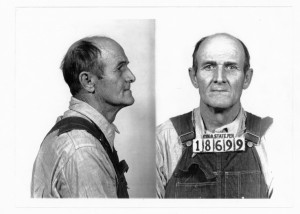
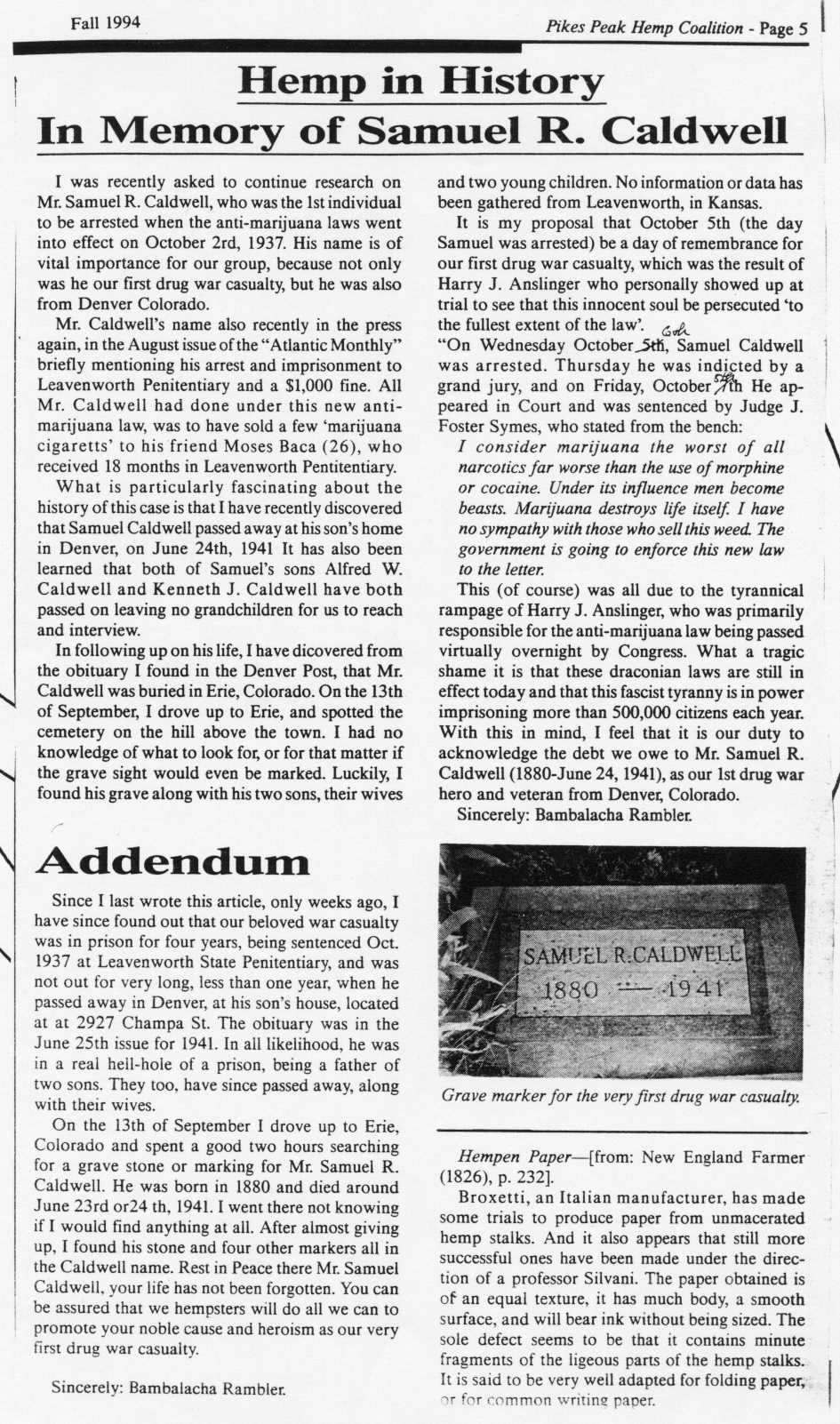
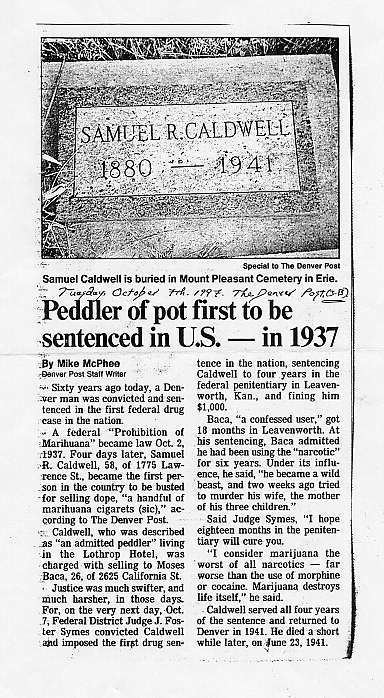
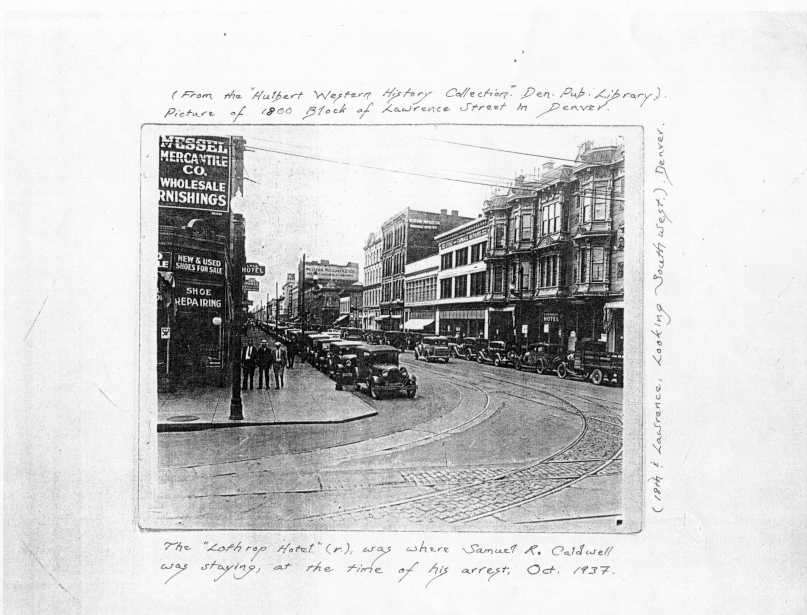

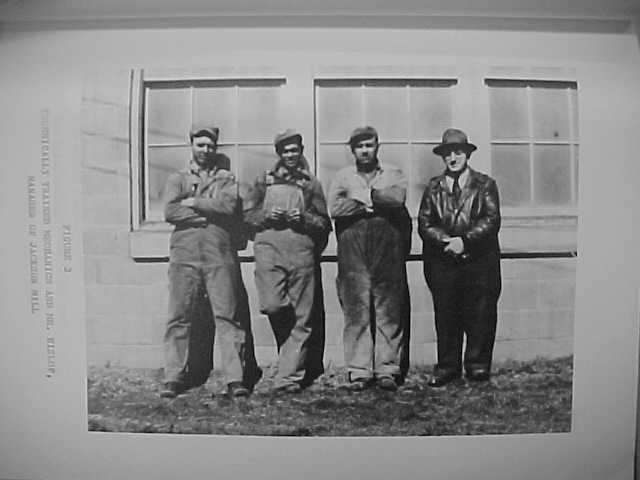


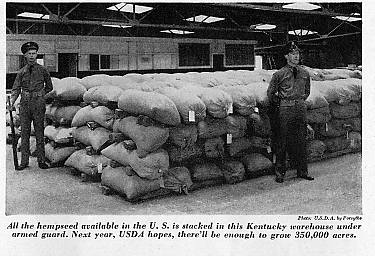
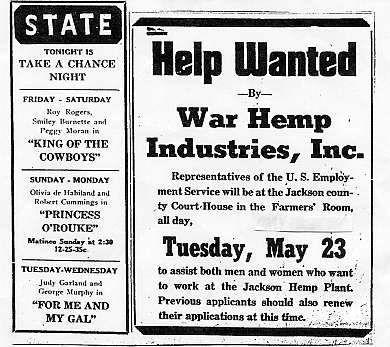
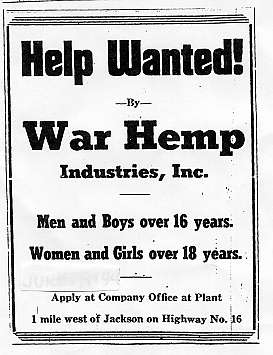
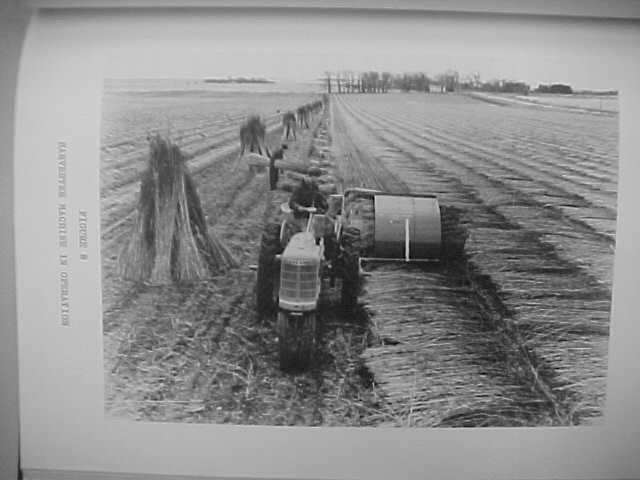
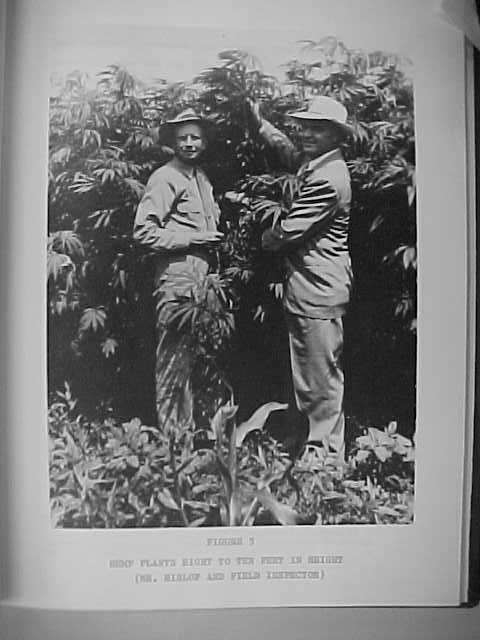
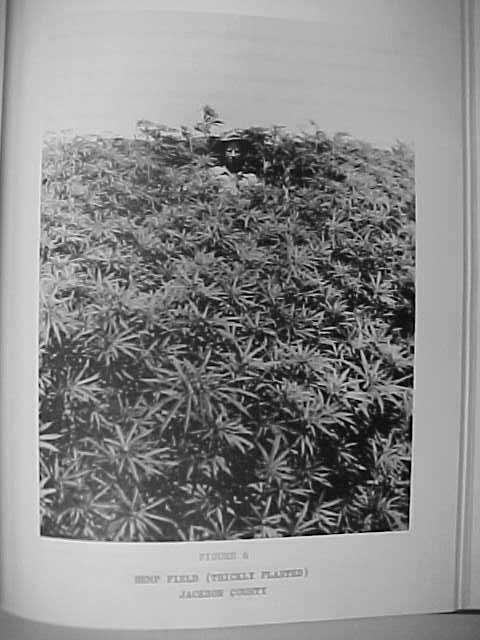
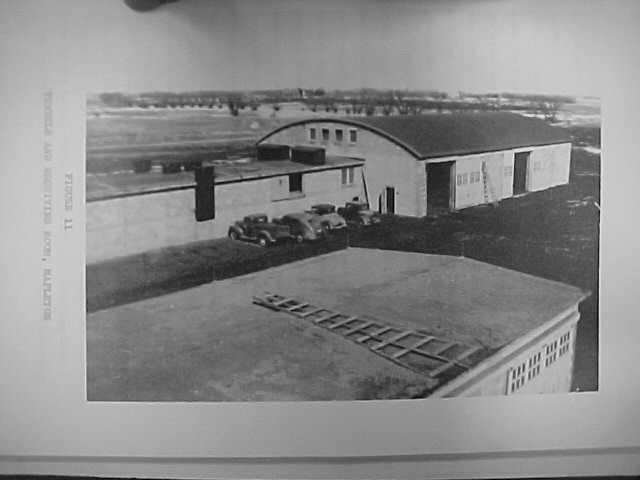

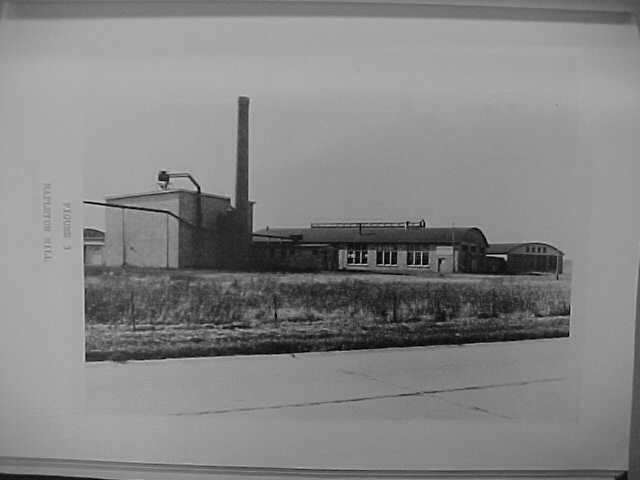

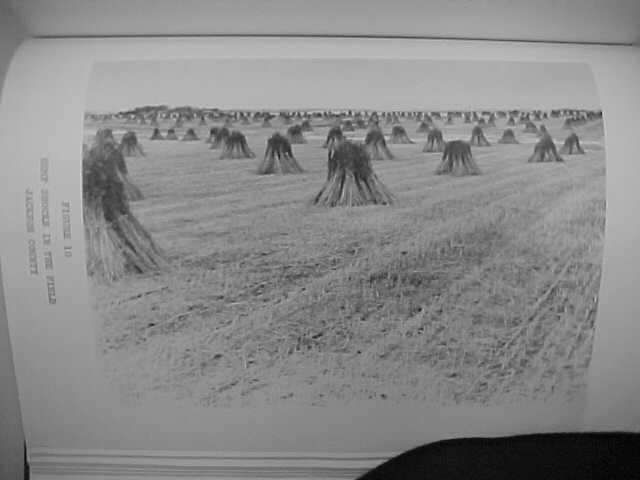
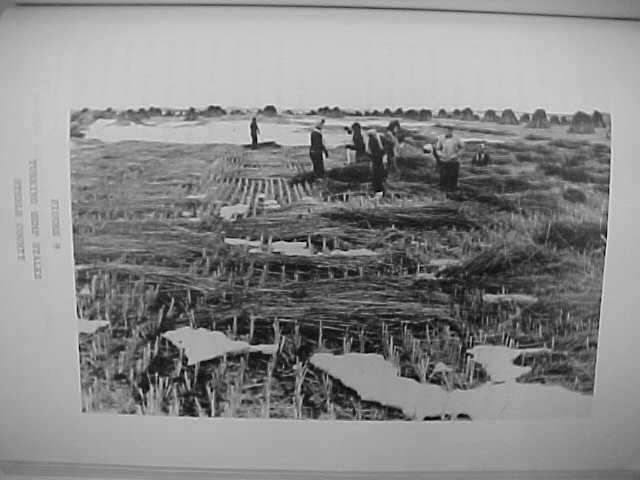

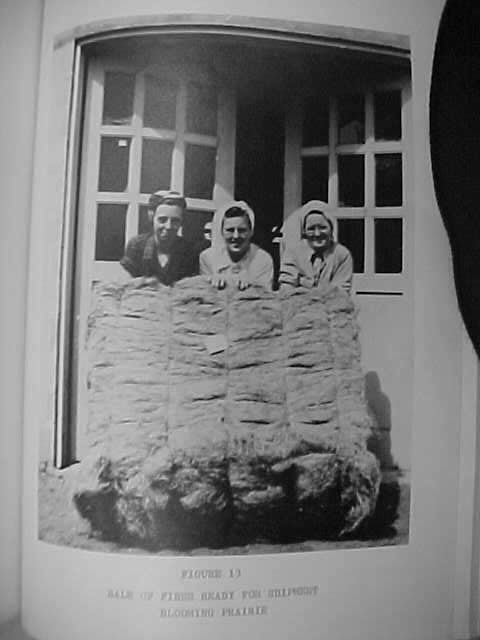
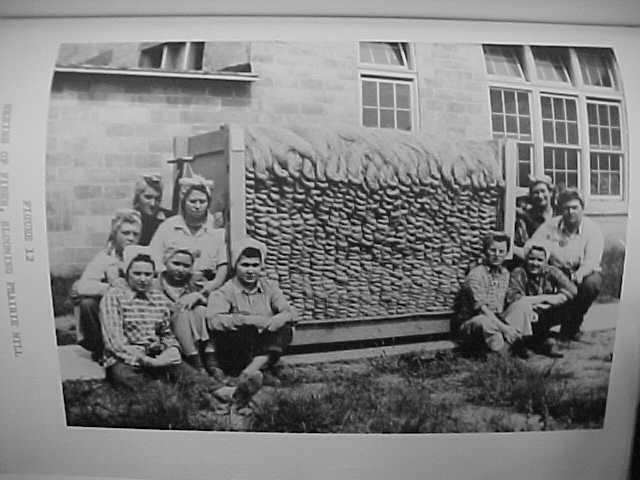
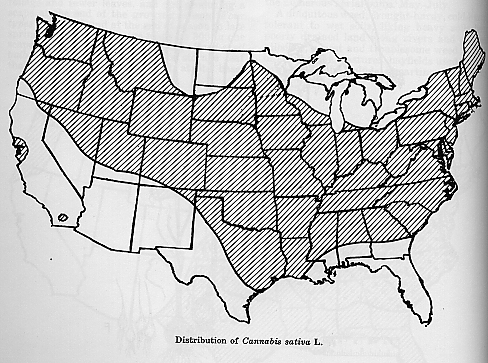
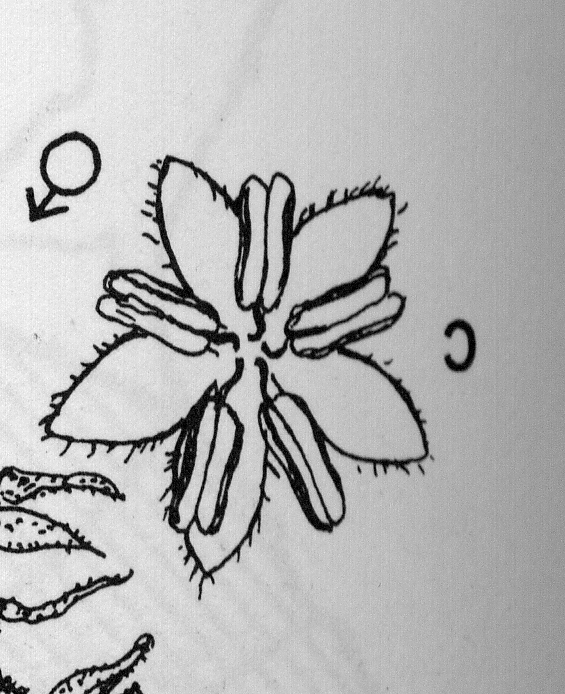
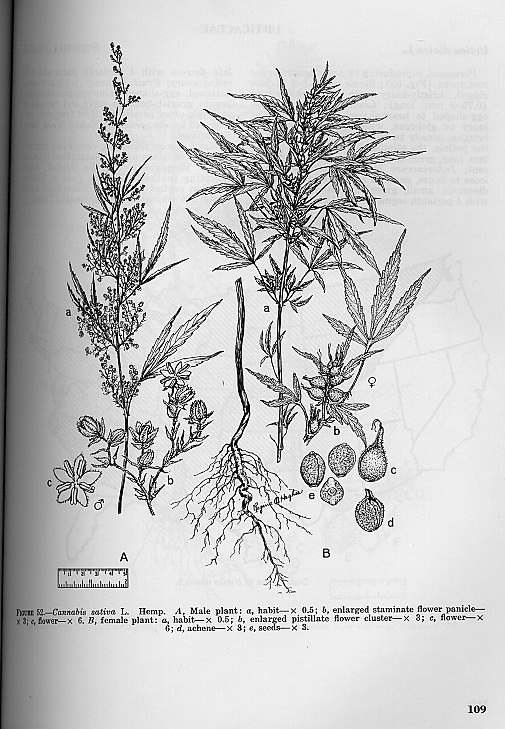
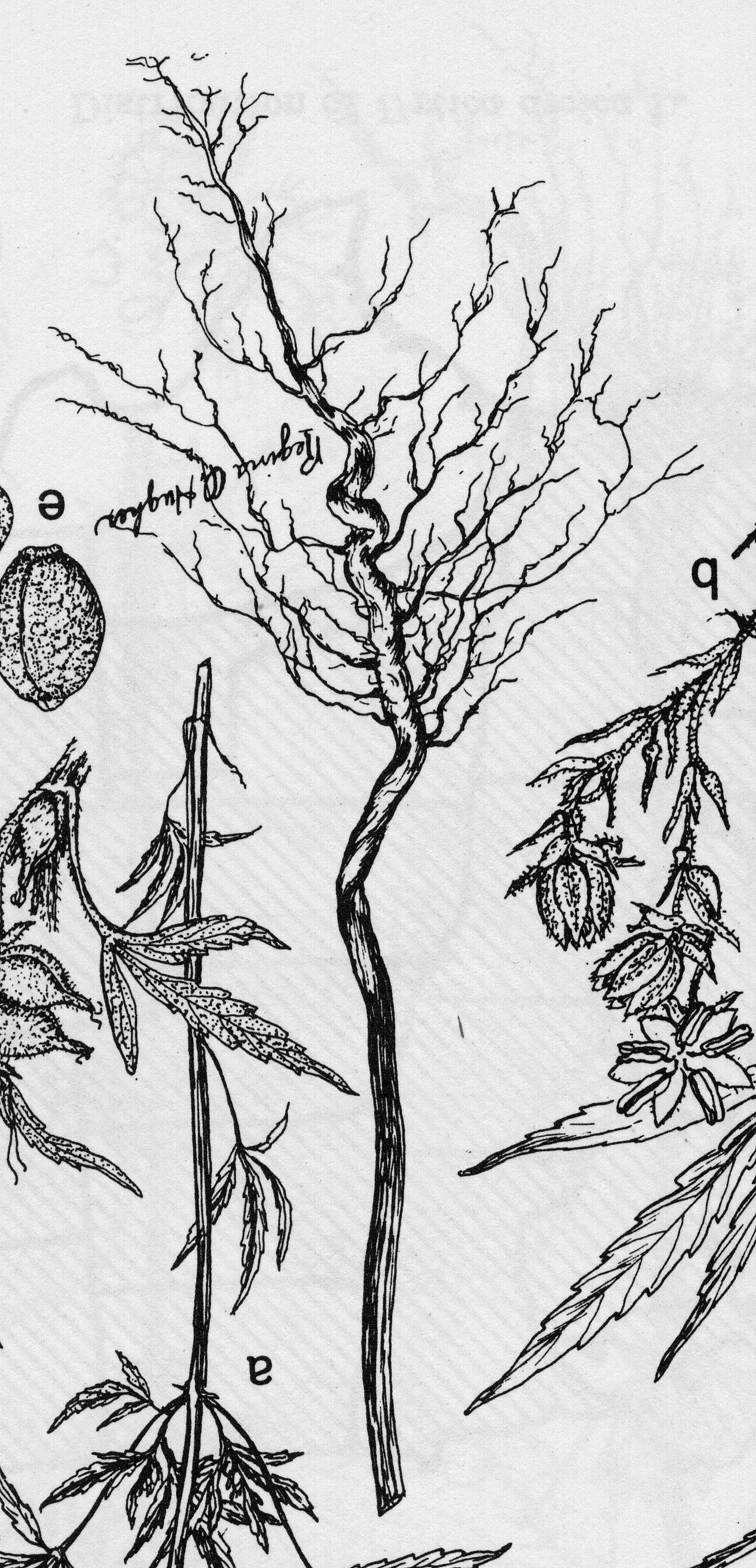
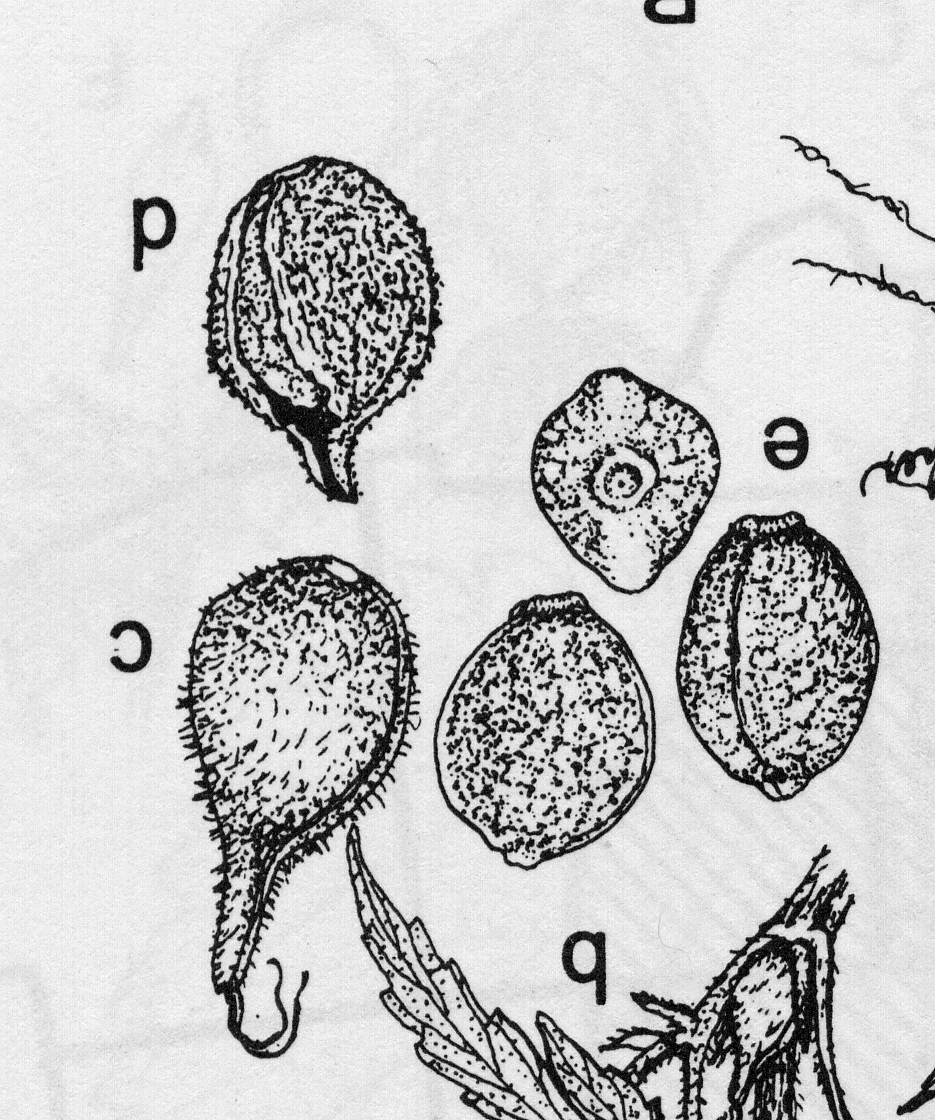




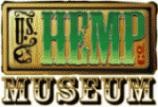
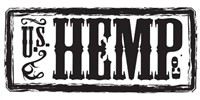
2 Responses to Prohibition